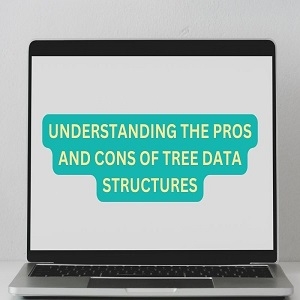Understanding The Pros and Cons of Tree Data StructuresPosted by Varun Virat on May 22nd, 2023  Introduction to Tree Data StructuresTree data structures are a type of hierarchical database structure used in computer programming. Trees use a specific set of terminology and principles to break down data into organized segments, making it easier to store, access, and analyze. In this article, we will explore the definition of trees, the terminology used when discussing tree structures, as well as the advantages and limitations they offer. Additionally, we will talk about when it may be advantageous to use tree structures for your needs. Trees A tree is a nonlinear data structure that stores hierarchical information in an organized fashion. This makes them particularly useful for certain tasks involving large sets of data; trees can help you efficiently store information while still allowing you access to key pieces quickly and easily. Generally speaking, trees feature “branches” that lead to smaller segments of information called “leaves” with each leaf representing one piece of the larger tree. Check Out: Data Science Course India Terminology Used When discussing tree structures or algorithms related to trees there are some key terms that are important to understand: Root Node: The top node in a tree structure located at the base Parent Node: A node with branches leading downwards from it Child Node: A node directly connected by a branch from its parent node Sibling Nodes: Nodes that share the same parent Leaf Nodes (Leaves): Terminal nodes with no children Advantages of Using Tree Data StructuresHere we will discuss the advantages of using tree data structures to help you understand their pros and cons. Flexible: One of the benefits of using tree data structures is that they can be used to represent any type of structured data. The hierarchical structure lends itself well to representing data like web pages or file systems which makes it easy to build applications on top of them. As the application grows, additional branches can be added without needing a lot of time for implementation. Check Out: Best Data Science Courses In India Searching: Tree data structures are excellent for searching because they allow elements to be searched in a particular order that is easiest for algorithms or programs. As elements are organized in a certain hierarchy, you can easily traverse them from the root node until you come across your desired item which saves time and ensures accuracy. Sorted Order: You can also sort elements within a tree structure according to any criteria you need. This is beneficial since it allows for better organization of elements and faster retrieval. Moreover, sorting helps speed up searches without having to go through each element individually which would waste a lot of time if there were hundreds or even thousands of elements present in the dataset. Data Visualization: Trees offer visual cues when representing information which aids better understanding and decision-making when dealing with large amounts of complex data. Items can be represented as nodes within a single ‘tree’ allowing users to view the relationships between items easily, thereby aiding their comprehension. Disadvantages of Using Tree Data Structures One primary disadvantage to using a tree structure is its memory usage. Trees are examples of memory sparse structures which means they require more space than other types of data structures for storage and retrieval. Furthermore, insertion and deletion operations have complexity levels of up to O(log n) which can become increasingly costly as datasets become larger. Furthermore, tree structures are also prone to becoming unbalanced due to the nature of how information is stored. This often leads to poor performance issues when dealing with large datasets as searches can take much longer than necessary due to the added height of the tree. Another disadvantage to using trees is their limited search capabilities. Unbalanced trees pose difficulty in locating specific items since they depend on traversal which may not allow for certain patterns that would help when searching for information within the structure. Furthermore, it’s difficult to store normal data outside of a tree structure due to its hierarchical nature — it requires special preprocessing methods in order to do so correctly, making it even more complex and expensive than using other types of data structures such as hash tables or linked lists. Lastly, linear traversal is not possible with tree structures since they’re based on binary branching rather than linear connections between elements — making traversing through them significantly more difficult and time-consuming compared to other options. Check out: Data Analytics Courses In India
Examples of Real-world Tree Use CasesWhen it comes to data organization and efficient searching, trees are a powerful tool that can help. A tree data structure is a hierarchical structure that mimics the structure of physical trees—it has a root node (the trunk), branches, leaves, and other nodes. Tree data structures are used for various purposes such as web page navigation systems, graph traversal algorithms, and database indexing. Before we dive into some examples of real-world tree use cases, let’s go over the pros and cons of using tree structures. The main benefit of using tree structures is that it allows for hierarchical organization of data. By organizing information hierarchically, you can store related items in different locations within the same branch of the tree. This makes it easy to view different parts of the data all at once and enables searching. Additionally, each node in a tree is linked to its parent or child nodes which help maintain relationships between different parts of the data set from an overall perspective. Check out: Data Science In India On the other hand, there are some drawbacks to using tree structures. For example, inserting new elements into a large hierarchy can be time-consuming because it may require multiple operations from a low-level node up to higher-level nodes in order to maintain relationships between different branches of the tree. Common Programming Mistakes When Working with TreesTrees are an important data structure in computer science and programming, making work more efficient for a range of applications. Before you dive into tree-based programming, it's important to understand some of the common mistakes beginners make when working with them. This article will explain the pros and cons of tree data structures, common oversights, and mistakes, strategies for prevention and debugging techniques, as well as memory management considerations, best practices for code optimization, and tips for refactoring and modifications. Let's start by looking at the aspects that make tree data structures beneficial. Trees provide an efficient method of storing hierarchical data such as family trees or airline route maps. Trees also allow quick access to stored information since they are structured like an upside-down pyramid with a single root node at the top and multiple branches extending from it. As each branch is traversed down from the root node, both the individual branches can be searched quickly compared to other data structures like linked lists or arrays which require linear scans through each element. Check Out: Masters In Data Science India However, there are some drawbacks to using trees as well. Firstly, inserting nodes into trees can get rather complicated depending on the number of existing entries present in the tree. Secondly, since trees have a hierarchical structure based on their root nodes, there is no quick way to move around elements without completely restructuring the entire tree. Like it? Share it!More by this author |


